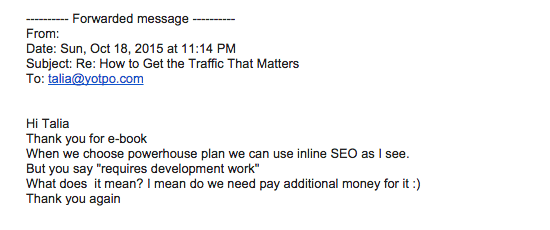Yotpo was lucky enough to grow really fast organically, without any marketing team in place, up until we earned about 70k users (compared to 120k we have now).
Back then, all of the goals and KPIs for dealing with this growth fell under the responsibility of our product team.
Despite the fact that we were growing quickly, at some point we realized we weren’t going to be able to move ahead without a dedicated marketing team.
At the time, the product team handled the bare minimum of our marketing needs, but we knew we were going to need more.
We were faced with a decision: Should we start a new team from scratch or build off of our existing product team?
We went with option one. It was a massive failure.
Why We Failed And What We Learned
We brought in a new team of experienced marketers. Despite having the expertise, skills and pedigree, our marketing team was disconnected from our product and ill-adjusted to the established company culture (one of the main reasons for our success).
Also, we realized that the traditional, old-school marketing team approach wasn’t going to work for our company.
Despite all the signs shouting at us to listen, it took us six months to realize we had made a mistake.

How Our Next Choice Strengthened Our Company
After admitting defeat and scraping up the pieces, we went with option number two — we built off of our existing product team to create a joint product-marketing team.
We had a few reasons for building marketing out of our product team. First of all, this team was in the unique position of knowing the product inside and out, so who better to market it?
Also, from a risk management perspective, it’s better to build off current employees, who understand the product and culture, than to start fresh.
When starting a completely new team, it’s impossible to predict whether the team culture will adapt to the existing company culture.
We also knew that today you can’t have a successful marketer without analytic skills, data orientation, and great understanding of product and technology, just as you can’t have a great product manager without a go-to market approach and knowledge of how to communicate well with users.
The Benefits of a Combined Product & Marketing Team
We began to build out from this core team, adding on content creators and lead generators and marketing automation experts to build up to the 20 person team we have today.
Despite enormously quick growth (we’re currently adding a handful of people to the team each month), the product-marketing team has not just survived, but proven to be one of the strongest parts of our company.
Here are just a few of the ways combining product and marketing teams can benefit companies in high-growth stages:
Data-driven Marketing
When we started to bring new people to the team for the marketing side of the existing product team, they quickly adapted and naturally began to follow the established culture and methods we had in place.
The three people who made up the product team before we integrated used event-triggered automation system (Vero for email, Intercom for in-product communication, and Qualaroo for action-driven surveys) to acquire and manage thousands of new customers per month.
As we began to build up our eCommerce marketing automation (we are using HubSpot), we built flows similar to those we had been using for the product side. The logic of both the product and marketing flows is remarkably similar, with automated, event-triggered flows personalized to our users.
Below is an example of a marketing flow, which looks remarkably similar to the flows many product teams use.

This allowed us to save a lot of time trying to build marketing automation from the ground up. We saw the spillover not just in our work processes, but in our employees’ work styles.
For example, Aimee, our talented blog manager, came to the team as a content writer. She is now an analytics machine.
Her content strategy and KPIs are based off of data and she is in charge of monitoring flows under her domain and forming her marketing strategy accordingly.
Marketing-minded Product Development
For a product-oriented company like Yotpo, keeping the marketing team close to the product allows product development to meet market needs.
When we recruited a new product manager, he achieved great results not only because he is an analytical, tech-oriented guy but also because he’s great with communication and understands good content.
He learned how to combine our technical needs with our vision for the product, even creating a formulaic system for prioritizing features.
Smooth Communication
The marketing team knows everything about the product development process and status and can influence feature prioritization, prepare for feature releases, give quick and correct answers for product-related questions coming from the community, and drive relevant feedback back to the product team.
For example, when a marketer received this question about the product, someone from marketing was able to answer quickly and effectively, without needing to consult someone in product.


Shared Resources and Talent
There are many areas of overlap that serve both sides. Our designers, content team, and automation-optimization experts support both product and marketing objectives, so it makes sense that they serve both sides.
Our marketing designer and UI/UX designer sit next to each other – not only are they able to share knowledge and consult each other, but it is much easier to keep the same language for both the product and marketing assets.
Just last week, our UX designer suggested to our blog manager, Aimee, that she add a welcome mat to the blog.
She created a quick mock up and sent it over to him.

He quickly made his own changes to improve the UX, and to Aimee’s surprise, he even improved the marketing by changing the text to be more effective. It’s a perfect example of how a product team member was also well-versed enough in marketing to give tips, even in an area that was not their expertise.

This has the effect of giving people trained in one area skills in the other, which brings enormous benefits in the long term.
Effective Work Due to Employee Flexibility
We always have (and will have) bottlenecks. With the combined team working so closely together, we have more flexibility for people from either side to work on the other one.

For example, when our marketing designer was recently overloaded with projects, the product designer, due to his understanding of her job, was easily able to help.
Creating a Lead Machine From Our Product
Because we operate on a freemium model, the product is a lead source just like any traditional marketing channel, like our website, PPC, social or blog.
The product manager also has a marketing mindset — designing the product in a way that will attract new users, nurture them into leads and convert them into sales.
Combining Product and Marketing is Great for Growing Companies
…but it’s not necessarily scale-able. As our 20-person team grows, we need to create scalable infrastructure to support bigger teams.
This means we will begin the process of gradually separating product and marketing. While we will still have regular joint meetings, it isn’t sustainable to have weekly meetings with all members (two-hour weekly meetings are no one’s favorite).
We also feel that the foundations of each of the teams are strong enough to focus on their core areas.
When I look back, I can say that starting the marketing team from the foundation of the product team was one of the best decisions we have made, but it requires careful planning to scale it up.













 Join a free demo, personalized to fit your needs
Join a free demo, personalized to fit your needs